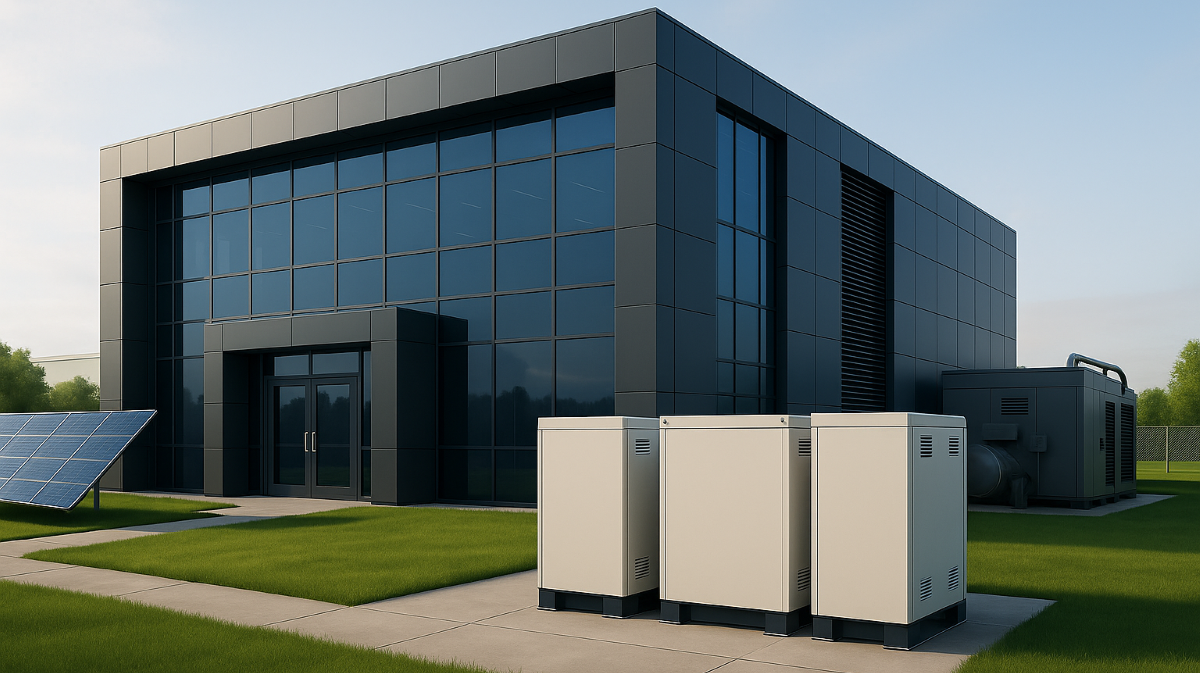7-minute read
Quick summary: Microgrids and DERMS offer data centers distinct paths to improve reliability, control costs, and support sustainability goals.
As data centers face escalating challenges around power reliability, sustainability, and capacity constraints, developers are increasingly turning to advanced energy management solutions. Microgrids have emerged as a compelling alternative to traditional grid connections for data center applications as utilities scramble to adjust to load-growth projections. These self-contained energy solutions offer data centers unprecedented control over their power infrastructure, enabling capabilities ranging from islanded operation during grid emergencies to sophisticated cost optimization and integration of renewables.
While DERMS provide valuable coordination of distributed resources within the utility framework, the unique requirements of data operations often demand specialized optimization, and this is where microgrids can offer value. Microgrids and DERMS represent distinct approaches to data center power management, with microgrids focusing on autonomous operation and physical isolation capabilities and DERMS emphasizing integrated resource coordination—each addressing different priorities in reliability, control, and grid interaction.
Key benefits of microgrids and DERMS for data centers
Resilience and reliability
With high capital requirements and revenue derived from consistent data output or AI training, data centers have a greater need for backup power than other load types on the grid. These financial conditions create a unique need for power reliability and drive a cost-benefit environment that particularly promotes expensive reliability solutions.
Data centers implementing microgrids gain unprecedented protection against grid outages and disruptions that could otherwise lead to costly downtime. Advanced islanding capabilities enable these systems to automatically disconnect from the main grid during emergencies while maintaining seamless power delivery to critical servers and infrastructure. This self-sufficient operation ensures business continuity even when regional power infrastructure fails, providing data center operators with a crucial competitive advantage in an industry where reliability metrics directly impact customer trust and contract retention. Even in a fast-changing microgrid market, reliability needs have been the main use case for microgrids and will continue to provide value for data center developers.
Article continues below.
WEBINAR
The DERMS journey: Keys to successful implementation
WHITE PAPER
Planning for net-zero utilities: Integrating renewables and DERs
Energy cost optimization
Microgrids offer data center operators sophisticated tools to manage increasingly volatile energy costs. Utilities continue to implement and investigate programs with flexible pricing structures, especially on the distribution side. By implementing peak-shaving strategies, facilities can significantly reduce demand charges, drawing from co-located energy resources during high-rate periods rather than pulling from the utility grid. Load shifting capabilities allow operations to align energy-intensive workloads with periods of lower electricity prices or higher renewable generation.
The combination of on-site generation, storage, and intelligent management systems creates opportunities to arbitrage energy markets and minimize utility costs while maintaining operational reliability. These use cases with dual benefits like cost savings and reliability make microgrids an even more attractive solution, even when considering the high cost of implementation.
Sustainability goals
As corporate sustainability commitments intensify, microgrids provide data centers with tangible paths toward decarbonization through seamless integration of renewable energy sources like solar arrays and wind turbines. Large increases in energy demand, like the projections from the current utility systems, come with the inevitable question of how much the energy demand will increase the carbon intensity of the grid.
Flexible generation solutions like microgrids or DERMS can offer distinctive opportunities to implement clean energy where it makes sense. These systems enable facilities to maximize the use of clean energy by storing excess production for use during peak demand or low-generation periods. For organizations facing investor and customer pressure around carbon emissions, microgrids offer measurable carbon footprint reductions while simultaneously improving operational resilience—a rare win-win in a sustainability landscape that transforms green initiatives from cost centers into strategic assets.
Power quality management
Sensitive computing equipment demands precise power parameters that utility grids often struggle to deliver consistently. Microgrids excel at voltage and frequency stabilization, creating a protective buffer between imperfect utility power and critical servers. Power conditioning within the microgrid infrastructure mitigates harmonics, transients, and other power quality issues that can degrade equipment performance or lifespan.
This enhanced power quality management reduces maintenance costs and extends hardware lifecycles, which is a large revenue driver for data centers. An overly simplified interconnection strategy might lead to complications that delay project energization, losing money for both developers and utilities. Microgrids can bridge this gap and create solutions that help both sides.
Microgrids and DERMS enable facilities to maximize the use of clean energy by storing excess production for use during peak demand or low-generation periods.
Capacity expansion
Due to the increase in projected load growth from a high number of energy-hungry data centers entering the electric system, concern about straining the existing grid has grown among operators. In regions facing grid capacity constraints, microgrids offer data centers a pathway to growth without the lengthy delays associated with utility infrastructure upgrades. Waiting for grid capacity upgrades can take three to four years, which means projects may go unapproved or result in lost investment, and utilities lose out on additional revenue.
By supplementing existing connections with local generation and storage, facilities can support higher energy needs and expand operations without waiting for utility permission or construction. In tandem with possible flexible loading conditions in AI training facilities, DERMS and microgrids can offer solutions to capacity constraints that thus far have been nonexistent in the grid. This advantage has proven particularly valuable in emerging tech hubs where grid infrastructure lags digital growth, allowing forward-thinking operators to secure strategic locations and scale operations according to business needs rather than utility timelines.
By supplementing existing connections with local generation and storage, facilities can support higher energy needs and expand operations without waiting for utility permission or construction.
Microgrids vs. DERMS: Comparing approaches to energy management for data centers
As data centers explore different solutions to managing interconnection and energy generation, understanding the fundamental differences between microgrids and DERMS becomes essential for strategic infrastructure planning. While both technologies aim to enhance energy reliability and efficiency, they approach these goals through slightly different design philosophies and operational mechanisms. Microgrids establish defined electrical boundaries with autonomous control capabilities, while DERMS focus on coordinating distributed resources across broader utility networks, creating important distinctions in how each solution addresses the critical power challenges facing modern computing facilities.
Autonomy vs. integration
While both technologies enhance energy management, microgrids provide data centers with true operational autonomy, a capability that DERMS cannot provide. Microgrids establish a self-contained energy system with independent control mechanisms capable of fully disconnecting from the wider grid when necessary. DERMS, by contrast, focuses on optimizing resources within the existing utility framework, requiring continuous grid connection and coordination.
For data centers in which independence from grid vulnerabilities represents a core value proposition, microgrids deliver sovereignty over energy resources that DERMS’ integration-focused approach cannot provide. For developers whose proposed data center site might face reduced challenges from reliability but higher barriers from an interconnection standpoint, DERMS might offer the better solution.
Scope of control
Microgrids operate within clearly defined physical boundaries containing generation, storage, and loads under unified management, creating a cohesive energy system tailored specifically to the data center’s needs. DERMS typically manages distributed resources across wider geographic areas with diverse ownership and operational objectives.
This focused scope gives microgrids an advantage in precision control and optimization specifically for critical computing environments, where energy decisions directly impact computational capability and business continuity rather than serving broader utility objectives that may not align with data center priorities.
Primary focus
The divergent core objectives of these technologies often determine their suitability for data center applications. Microgrids prioritize local resilience and self-sufficiency above all else, aligning perfectly with the zero-downtime mandate of modern computing facilities. DERMS emphasize broader system optimization and grid services that may sometimes conflict with the singular focus on uninterrupted operation that defines data center success.
This fundamental difference in priority makes microgrids the preferred choice for facilities where computational availability represents the foundation of their business model and customer promise. However, as more utilities build out their DERMS capabilities and offerings, a blend of options now appears and the solution for data centers will often come down to a case-by-case scenario.
A new era of energy infrastructure for data centers
The migration toward microgrids and DERMS in data center environments represents a strategic shift that extends far beyond simple backup power arrangements. Reliable backup power is not a new concept in power generation environments, but the capabilities and financial value for implementation have changed dramatically.
Microgrids offer a comprehensive solution addressing multiple challenges simultaneously: enhancing resilience through islanding capabilities, optimizing energy costs through intelligent resource management, advancing sustainability goals through renewable integration, improving power quality for sensitive equipment, and enabling capacity expansion in constrained environments. On the other side, DERMS provides valuable coordination within the broader utility framework, with an integration-focused approach and virtual control limitations that can provide the flexibility a developer needs for their data center project.
For facilities seeking to future-proof their energy infrastructure against an increasingly unstable grid environment while simultaneously addressing cost and sustainability pressures, microgrids and DERMS both provide a unique approach to interconnection that can deliver clear financial incentives, grid flexibility, and power reliability.

Powering a sustainable tomorrow
We partner with utilities to help them build a more resilient grid and move towards a cleaner, brighter future through
- Technology roadmaps
- System implementation
- AI-driven automation
- Analytics & predictive insights
- IT adoption
- Cloud optimization


